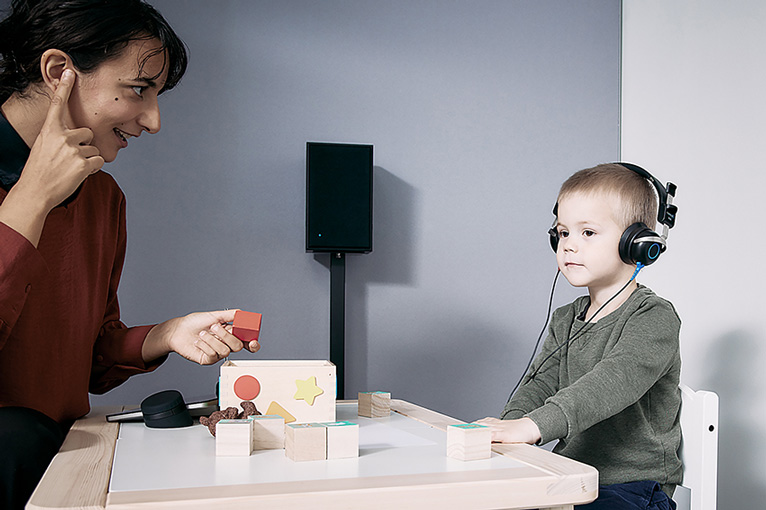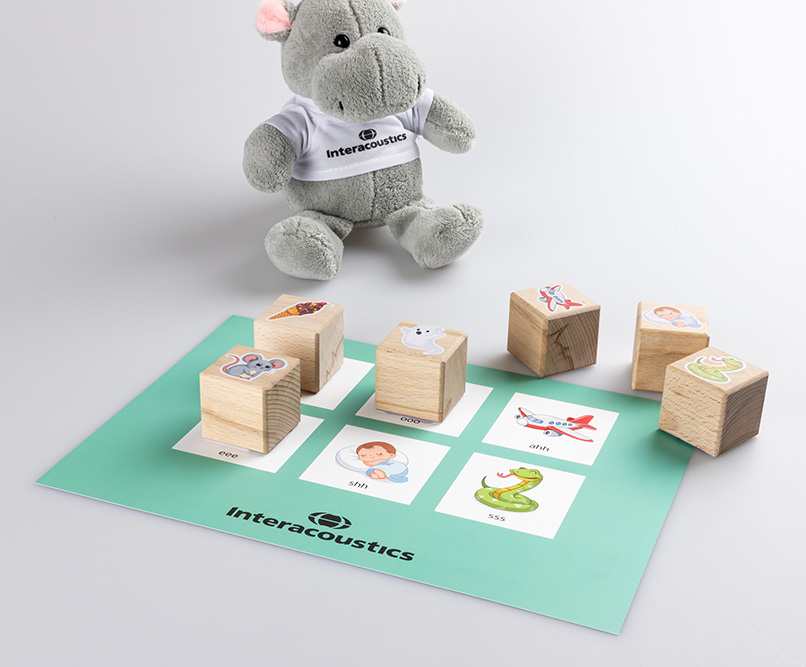Join the Interacoustics community and receive news about new products, events and much more
Making play audiometry a fun experience with the Equinox Evo
During the early stages of childhood, hearing testing often relies on engaging and visually stimulating methods to capture the child's attention and elicit responses. However, for an older child (approx. 2.5 years and above), the efficiency of tests such as visual reinforcement audiometry (VRA) is going to diminish.
Attention spans are shorter, and the child will be less prone to providing a clear head turn response, as they're aware that the screen is there, and it no longer captivates them the way that it does for infants.
So, we need to move on from VRA to a different type of test that is going to keep their attention for longer. And this is where we move on to play audiometry.
Like the challenges you may face in VRA, play audiometry comes with a couple of its own challenges.
Challenge 1: Prioritizing attention
One of the main challenges with play audiometry is that you play the game with the child while performing the test on the audiometer at the same time. So how do you prioritize where to place your attention without losing concentration and focus?
At the same time, this multitasking:
- Can be quite uncomfortable ergonomically for the clinician, with lots of twisting, bending, and reaching.
- And may make engagement difficult, with the child ideally facing away from the audiometer to reduce the risk of cueing (ability to ‘cheat’).
Solution: Flexibility to move around
By combining the Equinox Evo with the Touch Keyboard, you can alleviate the above challenges.
You can bring the Touch Keyboard into any position that you want to be in, which means that you’re no longer restricted by the audiometer controls being fixed and in one location. So, you get past the ergonomic twisting.
It’s also quite easy to screen the Touch Keyboard from view, and with no actual button pressing with its touch interface, it’s a lot more discreet in terms of stimulus presentation. This reduces the risk of cueing while also allowing you to get much closer to the child, meaning you can put your energy and your focus on them rather than onto the controls and the audiometer.
And that's where we want audiologists to have their attention; on the child and on the playing, with the audiometry almost taking place in the background.

Challenge 2: Unreliable aided testing
In children with hearing aids, aided testing is important to establish whether they can hear all the important sounds that they need to hear. For most children, this is about speech sounds for their speech and language development.
So, it's important to know whether the hearing aids are working and programmed properly in relation to speech sounds. And this is quite difficult with young children, both in VRA and in play audiometry.
Accessing calibrated speech material hasn't been that easy traditionally, so a lot of people have reverted to using live voice where you can use the microphone and present some sounds through the speaker (or in a more basic form, speak directly in front of the child).
But live voice is not calibrated, inconsistent, and comes with the risk of cueing. All of which cause difficulties in getting reliable and accurate results.
Solution: Engaging stimuli paired with accompanying toys
With the Equinox Evo’s pediatric module, you get a range of stimuli and toys to engage the child with.
One of these stimuli are the Ling-6 sounds, which are the gold standard when performing aided testing in the play audiometry age group. They consist of the following sounds:
- /ooo/
- /mmm/
- /eee/
- /sss/
- /shh/
- /ahh/
You can present these as a detection task or – as the child gets older – a discrimination task. Different phonemes may be of particular importance for individual children, such as the /sss/ and /shh/ phonemes being of particular importance for a child with a high frequency hearing loss.
To make the session more fun and interactive, the pediatric module also offers an accompanying mat and Ling-6 blocks, allowing the child to match the sound to the corresponding block (Figure 2).

Audiometry made for children
With the Equinox Evo’s pediatric module, and ideally bundling the Touch Keyboard into your solution, you’re in a very good position to:
- Produce more accurate and reliable results
- Provide fun and engaging play audiometry sessions
- And make life more comfortable and simpler for yourself
To learn more about how you can enhance your pediatric testing, discover the Equinox Evo.
Similar Topic
Stay up to date!
Subscribe to our newsletter and receive news on new products, seminars and much more.
By signing up, I accept to receive newsletter e-mails from Interacoustics. I can withdraw my consent at any time by using the ‘unsubscribe’-function included in each e-mail.
Click here and read our privacy notice, if you want to know more about how we treat and protect your personal data.
